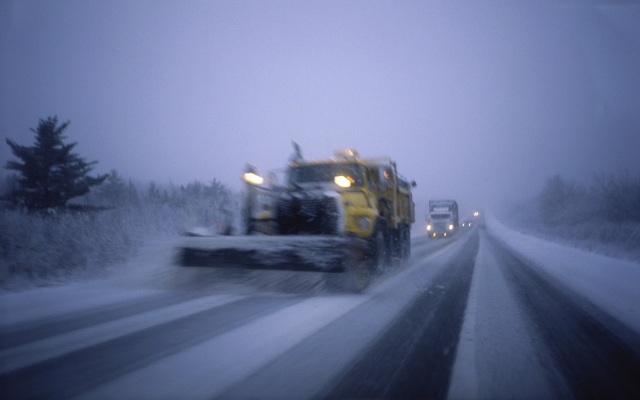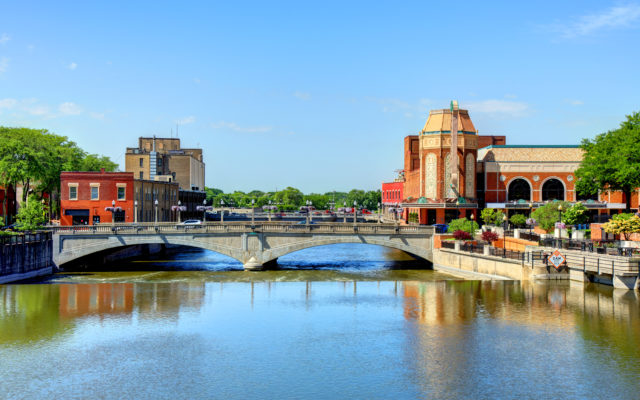Here are the Roads That Snow Plows Clear First

If you live on a small, residential street, don’t expect your road to be cleared very quickly…but you probably already knew that. What you may NOT already know is order in which streets are prioritized when the snow starts to fall. That means that if the snow is coming down heavy enough, plows may have to clean main arterties once, twice or CONTINUOUSLY before they even start on residential streets.
The City of Joliet has an entire webpage dedicated to their snow removal operations, and they list the order like this:
1. Major Arterials, hospital routes, hills, and the bridges.
2. Subdivision mains and collector streets.
3. All remaining subdivision streets.
4. Cul-de-sacs and dead ends.
5. The City does NOT plow alleys.
Hey, that makes perfect sense to me.
In Aurora, it’s a bit more vague, but the same general rules apply:
There are approximately 1,360 lane miles of roadway in the City. Of these, about 700 lane miles of roadway are designated as primary streets which have the highest volume of traffic and are designated as arterial or collector streets. The remaining 660 lane miles of roadway are designated as residential streets. Primary streets are plowed and/or salted first and during periods of heavy snow fall may be the only streets serviced until it completely stops snowing. Once its stops snowing, we move into the residential portion of the snow route.
Here’s Naperville‘s policy:
The goal is to clear all streets within 15 hours after snow stops falling; however, heavier snows often take longer to clear.
Arterial and main streets are plowed in the first phase of snow removal; residential side streets, cul-de-sacs, alleys and dead ends are cleared in the second phase. Cul-de-sacs are more difficult to clear than through streets as there is less space in parkways to dump snow without burying driveways, mailboxes, streetlights or fire hydrants.
What about St. Charles?
Plowing usually begins when 1.5” of snow has fallen and 2” or more has been forecast. The implementation of one of several plowing scenarios is determined by the amount of snow forecast and the duration of the storm. Plowing generally begins with main snow routes and the downtown area. Routes are selected depending on the time of day, the amount of snow falling and the forecast for the day. As snow accumulates to 2” or more, secondary roads are plowed to ensure the movement of traffic through neighborhoods and subdivisions. Full plowing operations consist of plowing all streets, cul-de-sacs, alleys and City parking lots. The goal is to have all areas plowed by the morning rush hour the day following the snowstorm. After an extremely heavy snow (12” or more), or back-to-back storms, City crews start by removing snow from intersections.
Elgin is a bit more vague on how they prioritize snow removal:
There are over 320 cul-de-sacs within the city which are cleared by a contractor working for the city beginning after 2 inches of snow. The Public Works Department generally provides snow and ice control for city owned roads. In addition, the city provides those same services for several IDOT jurisdictions including IL Rte 58, from Hiawatha to Liberty Street, IL Route 25, within the city limits, IL Route 31, within the city limits and IL Route 19 from Liberty Street to Rohrssen Road. It is the Public Works Department’s goal to plow all streets the department is responsible for within 24 hours after a storm of eight inches or more, within 12 hours after a storm of four to eight inches and within six hours after a storm of four inches or less.
And Wheaton:
Snow removal is performed in order of priority areas:
- Priority 1: Main thoroughfares, high volume areas and potentially dangerous areas such as railroad crossings, school zones, curves, bridges, and intersections
- Priority 2: Secondary and residential streets
- Priority 3: Cul-de-sacs and dead-ends will be the last areas plowed since pickup trucks rather than large snow plows must be used
You can watch this video about Wheaton’s Snow Operations.
It’s also important to keep in mind that not every roadway in a municipality is the municipality’s responsibility to clear! County crews clean the county roads while IDOT clears the state roads.
If the snow is really coming down quickly and it’s hard to even keep the main arteries, hospital routes, hills and bridges clean, then I wouldn’t expect any side and residential streets to even be touched until it slows down. What I mean is, don’t complain about your local snow removal. A vast majority of these people who plow streets are doing the best they possibly can, but many times snow falls faster than it can be plowed. And since main focus has to be on main roads, then you may not see a plow for a while.
That doesn’t mean they aren’t doing their job. As a matter of fact, it likely means they ARE doing their job…you just can’t see it right away looking through your window.
Thanks to the plow drivers out working over the next 48 hours. We appreciate you.
If you want to know your town’s policy, just Google “(your town) snow removal”.
Here’s a look at the latest forecast from the NWS:






